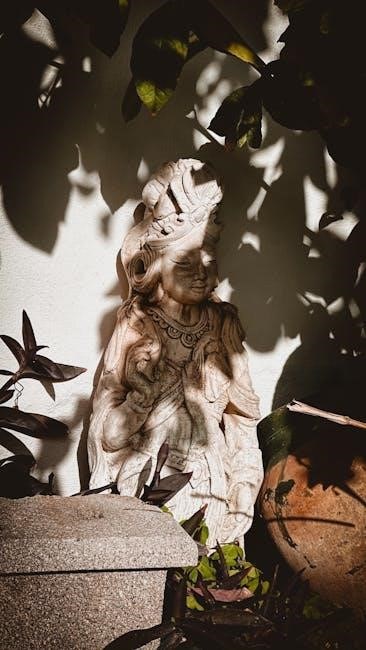The VITA Classical Shade Guide is a trusted tool for accurate tooth shade determination, featuring 16 natural shades organized into A, B, C, and D groups.
1.1 Overview of the VITA Classical Shade Guide
The VITA Classical Shade Guide is a widely recognized tool in dentistry, offering 16 natural tooth shades categorized into four main groups: A, B, C, and D. Each group represents distinct color nuances, with A1-A4 being reddish-brownish, B1-B4 reddish-yellowish, C1-C4 grayish, and D2-D4 reddish-gray. This system provides a standardized approach for shade matching, ensuring consistency and reliability. Its simplicity and effectiveness have made it a cornerstone in dental practices for selecting ceramic and resin materials. The guide’s portability and durability further enhance its practicality, allowing dentists to communicate effectively with laboratories and patients. Its enduring popularity underscores its value in achieving aesthetically pleasing and accurate restorations.
1.2 Brief History and Development
The VITA Classical Shade Guide was developed by VITA Zahnfabrik and first introduced over 60 years ago. Initially designed with 12 shades, it later expanded to 16, offering a comprehensive range for tooth shade matching. Its creation marked a significant advancement in dentistry, providing a standardized system for communicating tooth colors. Over the years, the guide has undergone improvements, such as the introduction of a stronger holder material for autoclaving, enhancing its durability. This evolution reflects VITA’s commitment to innovation and meeting the needs of modern dental practices. Today, it remains a cornerstone in dental aesthetics and restorations worldwide.
Understanding the VITA Classical Shade Guide
The VITA Classical Shade Guide is a standardized tool for determining tooth shades, featuring 16 natural shades organized into A, B, C, and D groups for precise matching;
2.1 What is the VITA Classical Shade Guide?
The VITA Classical Shade Guide is a widely recognized dental tool used for accurate tooth shade determination. It consists of 16 standardized shades categorized into four groups: A, B, C, and D. Each group represents distinct tooth color characteristics, with A being reddish-brown, B reddish-yellow, C grayish, and D reddish-gray. This guide enables dentists to select the most appropriate shades for restorations, ensuring natural and aesthetically pleasing outcomes. Its simplicity and reliability have made it a cornerstone in dental aesthetics and restorative procedures for over five decades;
2.2 Arrangement and Classification of Shades
The VITA Classical Shade Guide organizes tooth shades into four distinct groups: A, B, C, and D. Each group represents a specific color range, with A being reddish-brown, B reddish-yellow, C grayish, and D reddish-gray. Within each group, shades progress from light to dark, enabling systematic selection. The guide includes 16 shades in total, arranged to facilitate easy comparison and matching. This classification system allows dentists to identify the most suitable shade for restorations efficiently, ensuring consistent and accurate results. The logical arrangement simplifies the shade-matching process, making it a practical tool for dental professionals worldwide.
2.3 Materials and Construction
The VITA Classical Shade Guide is constructed using high-quality ceramic materials, ensuring durability and long-term color stability. The shade tabs are made from porcelain, providing accurate and consistent color representation. The guide features a sturdy holder designed for easy handling, with a new, stronger material that allows the entire unit to be autoclaved for sterilization. The shade tabs are securely attached to the holder, preventing wear and tear. The construction emphasizes practicality, with a compact design for easy storage and transport. The materials and build quality ensure the guide remains a reliable tool for dental professionals, maintaining its performance over time. This durability makes it a cost-effective investment for clinics.

Key Features and Benefits
The VITA Classical Shade Guide offers improved durability, standardized shade matching, and includes bleached shades for enhanced accuracy. Its new holder design allows autoclaving, ensuring hygiene and longevity.
3.1 Improved Holder Design
The VITA Classical Shade Guide features an enhanced holder design made from stronger materials, ensuring durability and longevity. This design allows the entire guide, including the holder and tabs, to be autoclaved, maintaining hygiene standards. The improved structure prevents wear and tear, providing consistent shade matching over time. Its robust construction ensures that the guide remains functional even with frequent use. This feature is particularly beneficial in clinical settings, where sterilization is critical. The holder’s design also improves ease of use, making it simpler for dentists to handle and compare shades accurately. This upgrade reflects VITA’s commitment to practicality and reliability in dental applications.
3.2 Inclusion of Bleached Shades
The VITA Classical Shade Guide now includes bleached shades, enhancing its versatility in modern dental practices. These additional shades cater to patients undergoing tooth whitening treatments, ensuring precise matching of lighter tones. The integration of bleached shades addresses the growing demand for aesthetic dentistry, offering dentists a practical tool for maintaining consistent results. This expansion allows for more accurate shade determination in cases requiring brighter, whiter teeth. The inclusion of these shades underscores VITA’s adaptability to evolving dental trends and patient preferences, making the guide a comprehensive solution for both natural and bleached tooth colorations. This feature is particularly valuable for achieving optimal aesthetic outcomes.
3.3 Standardized Shade Matching
The VITA Classical Shade Guide provides a standardized system for tooth shade matching, ensuring consistency and reliability in dental procedures. Its organized structure allows for precise communication between dental teams and laboratories, reducing errors in shade selection. The guide’s systematic arrangement of shades facilitates efficient and accurate matching, streamlining the restoration process. This standardization is crucial for achieving predictable aesthetic and functional outcomes in restorative dentistry. By adhering to a universal format, the VITA Classical Shade Guide enhances collaboration and ensures that patients receive consistent, high-quality care. Its reliability has made it a cornerstone in modern dental practice.
Utilization in Dental Practice
Dentists use the VITA Classical Shade Guide for precise tooth shade matching, ensuring aesthetic and functional outcomes in restorative dentistry, and aiding in consistent patient care.
4.1 Step-by-Step Guide to Using the Shade Guide
Using the VITA Classical Shade Guide involves a systematic approach. Begin by understanding the arrangement of shades, grouped into A, B, C, and D categories. Ensure the patient’s teeth are clean and dry for accurate comparison. Start by identifying the lightest shade, typically from the B group, and progress to darker shades. Compare the tabs against the patient’s teeth under natural light. Document the selected shade for records and communication with labs. Verify the shade by cross-referencing with adjacent tabs. This method ensures consistency and reliability in achieving precise tooth shade matching for restorative procedures. Proper use enhances patient satisfaction and aesthetic outcomes.
4.2 Clinical Applications in Dentistry
The VITA Classical Shade Guide is widely used in various dental procedures, including crown and bridge work, implants, and veneers. It aids in matching prosthetics to natural tooth colors, ensuring aesthetic results. Dentists rely on it for precise shade selection in restorative dentistry, enhancing patient satisfaction. Additionally, it is invaluable in tooth whitening cases for determining pre- and post-treatment shades. The guide facilitates communication between clinicians and lab technicians, ensuring consistent outcomes. Its versatility and reliability make it a cornerstone in both general and cosmetic dental practices, supporting functional and aesthetic dental solutions effectively.

Importance in Dentistry
The VITA Classical Shade Guide plays a pivotal role in achieving accurate tooth shade matching, which is crucial for both aesthetic and functional dental restorations, ensuring patient satisfaction and natural-looking results.
5.1 Reliability in Shade Determination
The VITA Classical Shade Guide is renowned for its reliability in shade determination, offering a standardized system that ensures consistency in dental procedures. Its 16 natural shades, organized into A, B, C, and D groups, provide a clear framework for matching tooth colors accurately. This reliability is crucial for achieving aesthetically pleasing and functional restorations, as it minimizes discrepancies between natural teeth and prosthetics. The guide’s systematic arrangement and durable shade tabs further enhance its effectiveness, making it a trusted tool for dentists worldwide. By reducing human error and improving communication between clinicians and laboratories, the VITA Classical Shade Guide has become indispensable in modern dentistry.
5.2 Role in Dental Aesthetics and Restorations
The VITA Classical Shade Guide plays a pivotal role in dental aesthetics and restorations by ensuring natural-looking results. Its 16 shades provide a comprehensive palette for matching tooth colors, crucial for crowns, veneers, and implants. The guide’s standardized system allows for precise communication between dentists and laboratories, ensuring restorations blend seamlessly with patients’ natural dentition. This consistency is vital for achieving both functional and aesthetic success, enhancing patient satisfaction and confidence. By offering a reliable method for shade selection, the VITA Classical Shade Guide remains an essential tool in modern dental practices, contributing to the artistry and precision of restorative dentistry.
5.3 Contribution to Patient Satisfaction
The VITA Classical Shade Guide significantly enhances patient satisfaction by ensuring restorations closely match natural tooth colors, delivering aesthetically pleasing results. Patients appreciate the precise shade matching, which boosts their confidence in their smile. The guide’s ability to maintain consistency in whitening regimens further satisfies patients seeking brighter teeth. By providing reliable tools for achieving desired aesthetic outcomes, the VITA Classical Shade Guide plays a key role in patient contentment and loyalty to dental practices. Its contribution to predictable and visually appealing results underscores its value in modern dentistry, where patient satisfaction is a top priority.

Comparison with Other VITA Systems
The VITA Classical Shade Guide differs from the 3D-Master system, offering 16 natural shades compared to 26 in 3D-Master, while Bleach Shades expand whitening options.
6.1 VITA Classical vs. VITA 3D-Master
The VITA Classical Shade Guide and the VITA 3D-Master system are two distinct tools for tooth shade determination. The Classical system offers 16 natural shades, organized into four groups (A, B, C, D), providing a straightforward solution for everyday use. In contrast, the 3D-Master system includes 26 natural shades and 29 levels of lightness, offering a more comprehensive and nuanced approach. While the Classical guide is ideal for general applications, the 3D-Master is preferred for complex aesthetic cases due to its broader range and scientific color space reproduction. Both systems complement each other, catering to different clinical needs and preferences.
6.2 VITA Classical vs. VITA Bleach Shades
The VITA Classical Shade Guide and VITA Bleach Shades cater to different dental needs. The Classical guide offers 16 natural tooth shades, ideal for restorative procedures, while Bleach Shades focus on lighter, whiter tones for tooth whitening. Bleach Shades provide a practical tool for maintaining and determining whitening regimens, addressing patient demands for brighter smiles. While the Classical system is versatile for general applications, Bleach Shades are specialized for aesthetic cases. Both tools enhance shade matching accuracy but serve distinct clinical purposes, ensuring dentists can address a wide range of patient requirements effectively.
Advantages of the VITA Classical Shade Guide
The VITA Classical Shade Guide offers simplicity, effectiveness, and reliability in tooth shade matching. Its improved holder design enhances durability, making it a trusted tool for decades.
7.1 Longevity and Durability
The VITA Classical Shade Guide is known for its exceptional longevity and durability. Constructed with high-quality materials, the guide withstands regular use and clinical environments. Its robust design ensures that the shade tabs remain intact and color-accurate over time, reducing the need for frequent replacements. The latest improvements, such as the stronger holder material, allow the entire guide to be autoclaved, enhancing its longevity. This durability makes it a long-lasting investment for dental practices, providing consistent and reliable shade matching for years. Its enduring performance contributes to its widespread acceptance and trust in the dental community globally.
7.2 Ease of Use
The VITA Classical Shade Guide is renowned for its simplicity and ease of use, making it accessible to both experienced and new dentists. The guide features 16 natural tooth shades arranged logically, allowing for quick identification and comparison. Its intuitive design, including a user-friendly holder, streamlines the shade-matching process. The ability to autoclave the entire guide enhances convenience and hygiene. Dentists can efficiently determine tooth shades with minimal training, reducing errors and saving time. This practicality ensures accurate and efficient shade matching, making it a preferred tool in modern dental practices. Its straightforward functionality has solidified its reputation as an essential resource for achieving consistent results.
7.3 Cost-Effectiveness
The VITA Classical Shade Guide offers exceptional value, balancing affordability with high-quality construction. Its durability ensures long-term use, reducing the need for frequent replacements and lowering overall costs. The guide’s robust materials withstand regular use, making it a cost-effective investment for dental practices. Additionally, its compatibility with a wide range of dental materials minimizes the need for multiple shade guides, further enhancing its economic efficiency. This combination of durability, versatility, and affordability makes the VITA Classical Shade Guide a financially sound choice for clinics seeking reliable shade-matching solutions without compromising on quality. Its cost-effectiveness is a key factor in its widespread adoption across the dental industry.
Limitations and Challenges
The VITA Classical Shade Guide may be limited by potential human error in shade matching and is restricted to the shades it provides, which may not cover all tooth color variations.
8.1 Potential for Human Error
The VITA Classical Shade Guide, while reliable, is not immune to human error. Despite its standardized system, inconsistencies can arise from subjective interpretations during shade matching. Factors such as lighting conditions and the dentist’s experience play a role. Additionally, variations in patient tooth color may not always align perfectly with the guide’s tabs, leading to potential mismatches. Proper training and adherence to best practices can mitigate these issues, ensuring more accurate results. Regular calibration and updated protocols are essential to minimize errors and enhance the guide’s effectiveness in clinical settings.
8.2 Limited by Available Shades
The VITA Classical Shade Guide is limited by its 16 natural shades, which may not fully capture the diversity of tooth colors in clinical practice. While effective for most cases, it may struggle with unique or less common tooth shades. This limitation can lead to compromises in achieving perfect matches, especially for patients with distinctive tooth hues or specific aesthetic demands. Despite its widespread use, the guide’s fixed range means it cannot always accommodate individual variations, potentially affecting the accuracy of shade determination in certain scenarios. However, it remains a reliable tool for standard dental applications, balancing practicality with clinical effectiveness.

Case Studies and Applications
The VITA Classical Shade Guide is widely applied in dental practices for restorative procedures, cosmetic dentistry, and tooth whitening, ensuring accurate shade matching and predictable outcomes.
9.1 Successful Implementations
The VITA Classical Shade Guide has been successfully implemented in numerous dental practices worldwide. Its reliability in shade determination has made it a cornerstone in restorative and cosmetic procedures. Dentists have reported high patient satisfaction due to the guide’s ability to ensure natural-looking results. The inclusion of bleached shades has further enhanced its utility in tooth whitening treatments. Many case studies highlight its effectiveness in achieving consistent and aesthetically pleasing outcomes. The guide’s durability and ease of use contribute to its widespread adoption and success in various clinical applications.
9.2 Real-World Applications
The VITA Classical Shade Guide is widely used in daily dental practice for crown and veneer shade matching, ensuring natural and aesthetically pleasing results. Its portability and durability make it ideal for chairside use. Dentists utilize it to communicate effectively with laboratories, ensuring consistent outcomes. The guide is also essential in tooth whitening procedures, where bleached shades help achieve desired results. Its standardized system simplifies shade selection, reducing errors and enhancing patient satisfaction. Many practices rely on it for routine restorative and cosmetic procedures, making it an indispensable tool in modern dentistry.

Future Trends and Developments
Future advancements may include integrating digital shade-matching technology and AI for enhanced accuracy. Upcoming updates could focus on expanding shade options and improving usability.
10.1 Technological Integrations
The integration of digital technology with the VITA Classical Shade Guide is a promising trend. AI-driven systems could enhance shade matching accuracy by analyzing digital dental images. Smart shade guides with real-time color calibration might become standard, reducing human error. Additionally, mobile apps could enable dentists to compare and select shades more efficiently. These innovations aim to streamline the shade-matching process while maintaining the reliability the VITA system is known for. Such advancements would not only improve efficiency but also elevate patient satisfaction in dental aesthetics and restorations.
10.2 Potential Enhancements
Future enhancements to the VITA Classical Shade Guide may include expanding the range of shades to accommodate diverse tooth colors. Bleached shades could be further refined to align with popular tooth whitening trends. Additionally, incorporating customizable shade tabs could allow dentists to tailor the guide to specific patient needs. Durable materials and ergonomic designs might also be introduced to improve longevity and usability. These potential updates aim to maintain the guide’s relevance in modern dentistry while addressing evolving patient demands and clinical requirements.
The VITA Classical Shade Guide remains a reliable tool for tooth shade determination, offering standardized shade matching and contributing significantly to dental aesthetics and restorations for decades.
11.1 Summary of Key Points
The VITA Classical Shade Guide is a reliable and widely used tool for tooth shade determination, offering 16 natural shades organized into A, B, C, and D groups. Its standardized system ensures consistent results, making it a cornerstone in dental aesthetics and restorations. The guide has been internationally recognized for decades, providing a simple yet effective solution for shade matching. Recent improvements, such as an autoclavable holder and the inclusion of bleached shades, have enhanced its functionality. Its longevity and ease of use make it a preferred choice among dental professionals, balancing tradition with modern advancements in dentistry.
11.2 Final Thoughts
References
References include the VITA official website, dental journals, and studies citing the guide, such as F. Floriani’s 2022 study on color variation in composite resins.
12.1 Bibliography
The bibliography includes sources like the VITA official website, dental journals, and studies such as F. Floriani’s 2022 study on color variation in composite resins. Additional references comprise academic articles, manufacturer manuals, and clinical reports. Key publications highlight the guide’s accuracy and clinical applications. Online resources from Darby Dental and Vident provide detailed product specifications. These sources collectively offer a comprehensive understanding of the VITA Classical Shade Guide’s development, features, and use in dentistry.
12.2 Online Resources
Key online resources include the Darby Dental Supply website, which provides detailed product descriptions and specifications for the VITA Classical Shade Guide. The Vident website offers insights into the guide’s features, including bleached shades and holder improvements. Additionally, the VITA Zahnfabrik official site offers technical documentation and clinical applications. Online forums like Dentaltown and ResearchGate feature discussions and studies on shade matching. E-commerce platforms like Amazon and eBay also provide access to the guide and related accessories.
